Abstract
This study analyzes 910 records in ProQuest Dissertations and Theses (PQDT) for doctoral dissertations in music composition completed 2004-2013, representing PhD, DMA, and DA documents from sixty-six institutions in the United States. Focusing on metadata created by the student authors, questions address to what extent works are identified as compositions or scores, how many keywords are assigned and how they are distributed, what subject categories are assigned, and to what degree titles of musical works are represented in the PQDT metadata fields of title, abstract, and keyword. Findings related to the possible impact of author-assigned metadata on findability indicated that the titles of musical works were not consistently included in ProQuest records, leading to a discussion of ways in which students, departments, and institutions can approach increasing discoverability of music compositions in PQDT. Practices such as crafting abstracts of composition dissertations in the form of program notes, consistently describing works as original compositions, and selecting a set of concise yet accurate keywords may ensure that these critical academic and creative documents can be identified and found in ProQuest, and by extension, any other resources that utilize PQDT metadata.
Introduction
Dissertation documents form an essential record of individual and institutional graduate study and accomplishment. Thorough and accurate descriptions—metadata—enable dissertations to be indexed and discovered for internal use by students, advisors, departments, and institutions, and for external use in scholarship and research. Quality metadata support multiple means of access, enabling discovery through libraries, institutional repositories, the Networked Digital Library of Theses and Dissertations, ProQuest, and internet search engines. The metadata process often begins with student authors, and submitting a dissertation may be a student’s first experience providing structured descriptions for a completed document. When dissertations are original creative works such as musical compositions, there are unique challenges in describing non-text documents to make them fully discoverable. There are more than thirty active doctoral programs in music composition in the United States,2 many of which require at least one original musical work to be submitted with or as a dissertation. Music composition is an excellent example of a field in which student authors must contend with the complications of describing nontraditional dissertations. This study examines the characteristics of authors’ descriptions of their music composition dissertations in ProQuest Dissertations and Theses (PQDT) and the potential impact of description on the identification and discovery of the culminating works of their doctoral careers.
The present study was inspired by a project at the author’s library to enhance access to composition dissertations by assigning Library of Congress subject headings and standardized forms of musical work titles in the local library catalog and the WorldCat catalog.3 As is common at many institutions, library and WorldCat records inherit dissertation titles and authors’ abstracts from ProQuest records, but inherited information does not consistently include information about musical medium, genre, text sources for vocal works, or collaborators. In some institutions, a student’s description may be the only descriptive information in a library or institutional repository (IR) record. Having authors initiate descriptive work can provide many benefits, contingent on the quality of the descriptions. Depending on the extent of additional description provided by libraries, the impact of authors’ description on findability may be significant. The local project led to questions about the fullness and quality of author-assigned metadata for composition dissertations from other institutions represented in PQDT and the impact on identification and discoverability.
ProQuest records offer the clearest way to isolate author-assigned metadata—other than system-supplied information and editor-supplied terms,4 records have only authors’ information, without additional information later supplied by library professionals (see Table 1 for a list of PQDT record fields). ProQuest is widely (though not universally) the repository of record for theses and dissertations.5 Its contribution to dissertation preservation and access is substantial, particularly in the United States. PQDT has been the official off-site repository of digital dissertations and theses for the Library of Congress since 1997.6 Search engines will retrieve and link to ProQuest metadata, and Google Books began indexing PQDT dissertations in 2007.7 While searches for specific authors or known dissertation titles will yield results as long as the author and title are spelled correctly, searches for all documents of a specific type or searches by department or field are dependent on additional metadata.
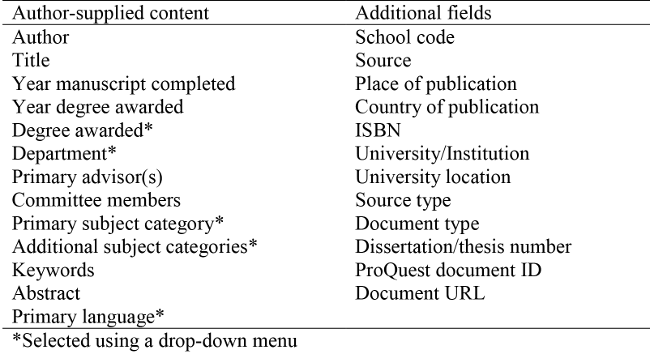
Table 1 - PQDT metadata fields
Description and access for music scores presents several challenges in PQDT. If full text is available, main documents are in PDF format. Nothing distinguishes a score or other non-text content within the PDF unless authors indicate content in keywords or abstracts. Dissertation titles, which may not match or include titles of the musical works, do not necessarily indicate genre, medium, or even that the work is a piece of music. This is most evident in single-word titles such as “Timepiece” (PhD, music composition, score)8 or “Resonance” (DMA, music composition, score).9 In contrast, dissertation titles in research-based fields, including other music disciplines, indicate topic and contain likely search terms, such as “Jeanne d’Arc on the 1870s Musical Stage: Jules Barbier and Charles Gounod’s Melodrama and Auguste Mermet’s Opera” (PhD, Music History and Historical Performance Practice).10 Furthermore, PQDT relies on full-text searching to produce maximum search results. Even with electronic theses and dissertations (ETDs), some scores are partially produced by hand and then scanned to PDF. If the character recognition process cannot interpret work titles written by hand or in unconventional fonts, searches for those works will yield no results even if titles are eye readable. Another layer of complexity is added with two-part dissertations, which include original musical works and either an extensive analysis of the works or an unrelated musicology or theory document.
This study, which examines access to work titles and representation of content in PQDT metadata fields, has a broad scope; it includes 910 PQDT records completed at 66 institutions over a ten-year period, 2004-2013. It provides a broad analysis of author-assigned metadata and raises specific questions for institutions wishing to maximize discoverability of their students’ doctoral work to investigate. The study addressed the following questions about records for music composition dissertations in PQDT:
• To what extent are musical works identified as original compositions or scores?
• How many keywords are assigned per record?
• How are keywords distributed?
• To what degree are musical work titles represented in PQTD metadata; specifically, title, keywords, and abstract fields?
• What PQDT subject categories do authors select?
Literature review
Much of the literature discussing subjects, keywords, and titles in the description of theses and dissertations compares metadata created by authors to description created by catalogers at university libraries. McCutcheon examined how multiple sources of metadata for ETDs—author-assigned and library-created—promote access and enable some automation and repurposing of records.11 An essential principle of using author-assigned metadata as a harvestable source for later enhancement by catalogers emerged: “The descriptive record created by automatic harvesting is only as good as the quality of the author-supplied metadata.”12 Lubas presented a case study and best practices for metadata for ETDs, suggesting that providing menus for authors to select names of departments and professors would contribute toward higher quality metadata in IRs.13 Strader conducted a study of ETDs at Ohio State University, comparing author-assigned keywords to Library of Congress Subject Headings (LCSH) as well as titles and abstracts.14 Strader concluded that LCSH and keywords are complementary in that each provides unique terms, though keywords add less value when abstracts are included in catalog records because of the strong overlap between author-assigned keywords and abstract text. Building on Strader’s study, Schwing, McCutcheon, and Maurer examined the unique value of author-assigned keywords and keyword matches to titles and abstracts in ETD records at Kent State University and further investigated the issue of partial matching between LCSH and keywords.15 They concluded that author-supplied keywords and LCSH added uniqueness and discoverability when compared to titles, but low uniqueness compared to abstracts.16 Previously, Maurer, McCutcheon, and Schwing reported that author-supplied metadata increase findability significantly, measuring application impact of author-supplied metadata at 79% when abstracts are included.17 Keller’s 1992 study of master’s theses at Indiana State University found that longer titles did not correlate with a greater match of keywords and LCSH.18
Two general studies raised title-related issues relevant to music composition. Sapon-White and Hansbrough analyzed the relative frequency of library checkouts of local dissertations with LCSH and those without.19 They noted that “some dissertations in the humanities have nondescriptive, even whimsical, titles” and suggest that although none were present in their study, these “whimsical” titles are unlikely to be retrieved by keyword.20 Keller specifically excluded literature theses, because “titles would not be typical because there are more imaginary titles which would have no chance of match. … Literature subjects could be seen at the outset to have totally different reasons for match and non-match of subject and keyword than other disciplines.”21
Fineman and Dougan each addressed music dissertations exclusively. Fineman discussed potential archival and multimedia challenges with electronically produced theses and dissertations in all music sub-disciplines, but did not emphasize metadata.22 Dougan compared findability and accessibility of musicology dissertations from three universities in the music-specific subscription databases RILM and Music Index, Doctoral Dissertations in Musicology, and PQDT.23 Wolverton, Hoover, and Fowler mentioned music in their survey on subject analysis of theses and dissertations. In their study, 79% of respondents reported assigning LCSH for theses and dissertations,24 and 13% of libraries targeted specific disciplines for subject analysis, with music listed as one of the programs.25
The search for literature related to creative dissertations in other arts fields indicated scarce discussion in North America, likely because master’s-level degrees are typically terminal in visual art, dance, and creative writing. A small number of doctoral creative writing programs require creative writing as the dissertation; literature specifically addressing description was not identified.
Method
Criteria
This study analyzes PQDT records for doctoral dissertations containing at least one original, creative musical work, submitted from United States institutions with indicated completion dates 2004 through 2013. “Musical work” was defined to include traditionally notated scores, descriptions or documentation of electronic or multimedia works, and other genres where the author’s contribution was sound or music: new media projects, music theater, dance pieces, collaborations, and sound-based installations. Records were included if a musical work was included or referenced in submitted supplementary material only. Citation-only records were included if the PQDT record indicated that dissertation content met the criteria for musical work; records citing only the written portion of a multi-part dissertation (a theoretical or analytical work unrelated to an original musical work) were excluded. Dissertations documenting a computer program or invented instrument used to compose were included only if specific works were discussed in detail.
Identifying records
A list of universities offering doctoral composition degrees was compiled using the program index in the 2002-2003, 2005-2006, and 2012-2013 editions of The College Music Society Directory of Music Faculties in Colleges and Universities, U.S. and Canada. The list included all programs labeled with the term “composition” and additional programs potentially offering a specialization in composition, including Church Music, Computer Music, Electronic Art, Electronic Music & Multimedia, Integrative Studies, Music, Music Ministry, and Musical Arts. All PhD programs were included. Additional doctoral degrees (DMA, DA, etc.) were included unless current school information stated that a culminating document (dissertation or DMA document) was not required. Institutions with no PQDT presence, as determined through searches, were eliminated. A total of sixty-six institutions, some with multiple degree programs, were included.
PQDT records for individual dissertations were identified through multiple searches in PQDT. Using the look-up feature for institution, with manuscript type limited to “Doctoral dissertations” and date limit applied, each of the following searches was conducted for each institution:
DEP [department]: music
DG [degree]: DMA [if applicable]
CMT [committee member]: [faculty surnames from CMS directory]
ANY [anywhere]: music
ANY [anywhere]: “original composition” [phrase search]
If results suggested the searches above might not have resulted in maximum retrieval, all records for the institution were retrieved. Records for ambiguous titles that might be related to music were reviewed, as were those with “whimsical” titles. If the abstract did not clearly indicate that the dissertation included a musical work—common for institutions also requiring an unrelated written essay—the dissertation full text was reviewed for a score or documentation of creative projects. If necessary, internet searches were conducted in an attempt to locate information that might indicate a student’s specific degree program. A total of 910 records met the criteria for this study (N = 910). All dissertations meeting the criteria were included. Information about each dissertation was recorded using an Excel spreadsheet.
Original composition/Music score
The phrase “original composition” emerged early in the data-gathering phase as a frequently used keyword. Each record was examined for the exact phrases “original composition” or “with original composition” as a measure of indication of content other than a written, analytic work. Terms were identified using Excel searches, then manually reviewed for accurate matching. The process was repeated for “score” and “scores.”
Keyword count and distribution
The term “keywords” used here includes single words and keyword phrases. The number of keywords within a single PQDT record was determined in Excel, using comma delimiters and manual adjustments to account for inverted names and other integrated commas. The total keyword count and distribution was obtained by converting the list of all keywords to a semicolon-delimited text file, then using Python to normalize capitalization, parse terms, and generate a histogram.
Musical work titles
To evaluate to what the extent authors included titles of their musical works in PQDT records, titles of musical works used by the composer needed to be identified. In order of descending preference, work titles were based on:
• Separate score title page, title above the first line of music, or full-text description of a nontraditional work in PQDT full text
• Score title page, title above the first line of music, or video/visual credits in PQDT supplemental files
• Dissertation table of contents in PQDT full text
• Dissertation title page in PQDT full text.
For the 115 records without full text in PQDT, if the full text was not available in an IR or elsewhere, work titles as found in the PQDT dissertation title or abstract, or in external sources (library catalogs, academic department pages, or authors’ personal web sites) were treated as full titles.
Inclusion of work titles in three PQDT metadata fields was assessed: title (TI index), keyword (DISKW index), and abstract (AB index). For a field to qualify as including a musical work title, the title in that field needed to be sufficient both to identify the work and to retrieve the record using an index search. This excluded titles used incidentally (a keyword search retrieves the record, but the terms do not refer to or identify the author’s musical work) and titles with typographic errors (the title of the musical work is identifiable, but an index search for the correctly spelled work title fails). To be treated as a match within the keyword field, words needed to appear within a single keyword phrase.
Initial articles in any language and subtitles for works with distinctive titles were omitted. Forms of numbers in work titles varied (e.g., Five Songs, 20 Episodes, Paths II); the form used by the composer was used for comparison. Various configurations of title, medium, and number or key appeared in titles consisting of compositional forms such as “concerto” or “sonata.” In general, titles with any arrangement of terms indicating type of composition, serial number, and featured instrument—if used by the author in the work’s title—were considered matches. A match on a distinctive subtitle alone was considered sufficient.
Title representation was scored numerically. The value “1” was assigned if the title was represented in a field; the value “0” if not. For dissertations containing multiple works, the value was determined by dividing the number of works represented in the metadata by the total number of works. This resulted in scores ranging from 0 to 1 in each field and cumulative scores for titles in title, keyword, and abstract fields ranging from 0 to 3.
ProQuest subject categories
ProQuest employs broad subject areas called “subject categories.” During the submission process, authors are instructed to select a primary subject category that best describes their field and may select up to two more. “Music” is available as a category within Fine and Performing Arts.26 Categories and accompanying ProQuest numeric codes in each record were recorded
Findings
To what extent are musical works identified as original compositions or scores in PQDT records?
The exact phrases “original composition” or “with original composition” were present in 699 of 910 records (76.81%); 24 records contained both. The terms “score” or “scores,” alone or in combination with other terms, occurred in the keyword field in 24 of 910 records (2.64%). The terms were preceded by “music” or “musical” in 9 of the 24.
How many keywords are assigned per record?
PQDT records contained at least one and up to 28 keywords, with 91.98% of records containing 3 through 10. The mean number of keywords per record was 6.9, with a median of 7. The most common number of keywords used was 8 (148 records). For a complete distribution, please see Figure 1.
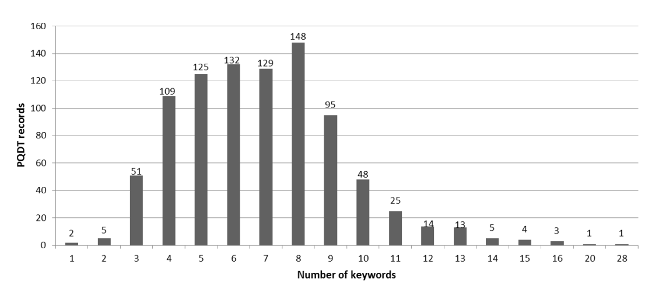
Figure 1. Number of keywords/keyword phrases per PQDT record
How are keywords distributed?
There were 2,539 unique keywords, including 2,123 present in only one record and 184 present in two. The most common keywords were “Communication and the arts” (possibly assigned by PQDT editors),27 “original composition,” “orchestra,” and “composition.” Table 2 lists terms and number of occurrences for keywords occurring in at least 20 records, with a comparison of number of occurrences when similar terms are clustered together.
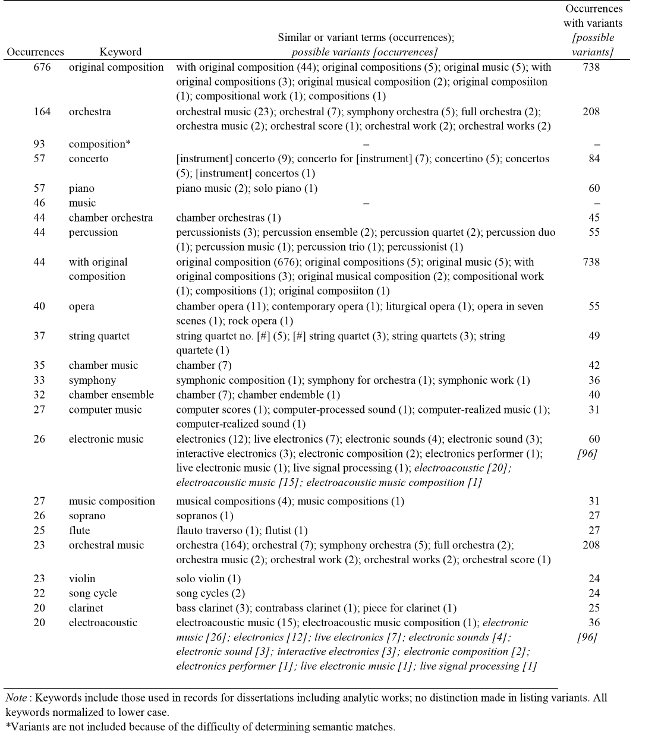
Table 2. Keywords occurring in at least 20 PQDT records and possible variants (editor-assigned terms omitted)
To what degree are musical work titles represented in PQTD metadata: title, keyword, and abstract fields?
Work title representation in PQDT metadata differs when accounting for titles of all works and titles of at least one work. Of 909 records with a discernable number of works, 115 included more than one work. Of those, one contained 13 works and the remainder 11 or fewer. Work titles for all works were included in at least one field in 812 records (89.23%); titles for at least one work were included in at least one field in 817 records (89.78%). Work titles of all works were represented in all three fields in 419 records (46.04%) and in 421 (46.26%) for at least one work. The cumulative title representation score of all three fields was 0 for 93 records (10.22%), 1 for 103 records (11.32%), 2 for 277 records (30.44%), and 3 for 419 records (46.04%) (remaining scores were intermediate values). Please see Table 3 for separate scores for title, keyword, and abstract fields, and Figure 2 for overlapping representation in the three fields.

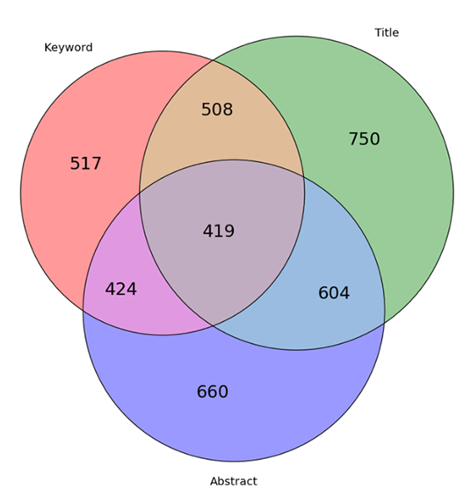
Table 3. Work title representation score(s) in PQDT keyword, dissertation title, and abstract fields (N=910) and Figure 2. Records with all work titles present in PQDT keyword, title, and abstract fields Note: Not shown: 98 records lacking titles in each field
What primary and additional subject categories do authors select?
The PQDT records contained between one and four subject categories. In 722 records, only one category was present. The subject category “Music” occurred in 906 of 910 records. Remaining records contained Fine Arts, Dance, Performing Arts, or Music Education. A total of 68 unique subject categories were present (combining earlier and later numeric codes for Music). Thirty five occurred in only one record, and 14 occurred in two records. Please see Table 4 for counts by subject categories for categories occurring in at least three records.
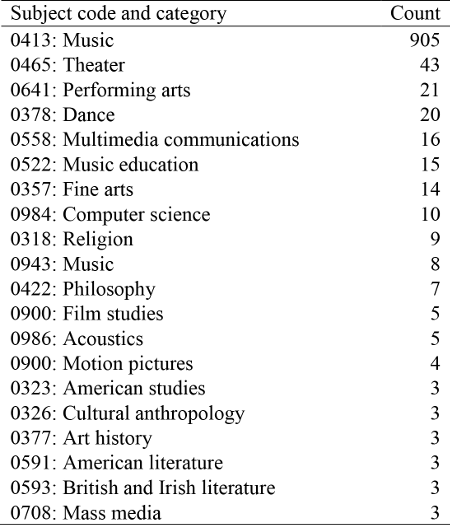
Table 4. PQDT subject categories occurring in more than two records (N=910)
Discussion
Identification as original compositions or scores
“Original composition,” present in just over three quarters of the records, could theoretically be applied to other disciplines. Most PQDT records for creative writing dissertations, to which the term could also apply, contain “original writing” instead. The consistent use of “original composition” applied to musical works would bring works together in a search, though the results might include additional, nonmusical works.
The benefit of the keywords “score” or “scores” to discovery is unclear. In the absence of a way to indicate content other than text in PQDT, “score” could clarify individual records, but multiple nonmusical meanings may render it useful for searches only if combined with some indication of music. “Score” would be inaccurate for installations, mixed media, improvisations, and some works for fixed media/electronics. The addition of a ProQuest thesaurus for content or document type terms (text, music notation, artwork, poetry, etc.) would force more consistent description than author-assigned keywords.
Keywords
Distribution that accounts for possible clusters/semantic overlap across the sample and redundancy within single records suggests that consistency and accuracy may be of more importance than number of keywords. Including different configurations of identical concepts (Figure 3) enables hyperlinks within PQDT, but does not affect default searches, in which word order does not matter. PQDT currently allows authors to provide up to six keywords in the ETD Administrator, which may prompt more judicious selection in future submissions. Typos in keywords, though not widespread, included misspellings of work titles, instruments, and genres (e.g., Folkoric instruments, Piano and ochestra, Original composiiton, Multimedia intallation).

Figure 3. PQDT Keywords containing identical concepts in multiple wordings.
Note: Commas separating PQDT keywords have been replaced with semicolons for clarity.
Dissertation consists of the score for the work Trio, for Violin, Clarinet in A and Marimba,
and the written text, “Layered Structures.” Source: Thomas, “Composition with Layered Structures”
(ProQuest record)
Musical work titles
The target for successful access to musical works is representation of 100% of titles of contained works in PQDT metadata, meaning work titles are both searchable and identifiable as such. With approximately ten percent of records scoring zero for each field (title, keyword, abstract)—meaning musical work titles are completely absent from PQDT metadata—that target is not met.
ProQuest subject categories
The occurrence of “Music” in nearly all records indicates authors are appropriately representing their work with subject categories. The four records with a different primary subject category used terms more accurate than “Music” for those dissertations. Additional subject categories that appear unrelated to composition, such as “cultural anthropology,” often apply to the analytical or musicological portion. A separate, browseable index correlating exactly to primary subject categories would greatly improve efficient searching by discipline in PQDT.
Abstracts
Review of abstract text revealed significant variation in detail. For original works, thorough abstracts include information on work title(s), medium/performing forces, duration, year of composition, and additional collaborators or text authors. These do not necessarily need to be extensive, and these tend to resemble program notes (Figure 4). Abstracts with less information about the musical works ranged from short statements that did not cover critical information, to lengthy texts that did not address the musical works (Figure 5). Access to musical works for combination documents (composition and unrelated essay) will be enhanced by noting the inclusion of original works, if departmental practice permits (Figure 6).
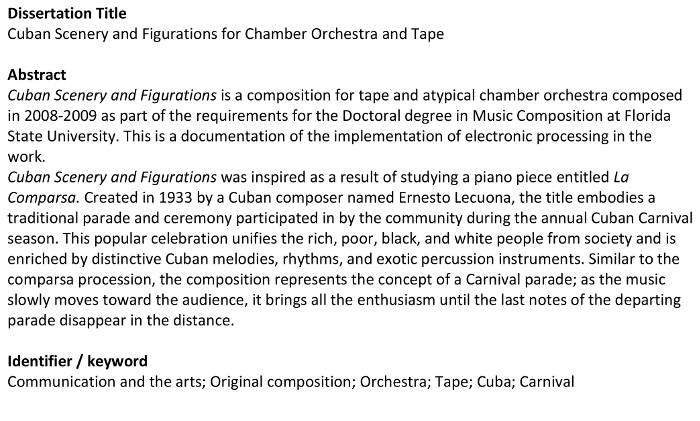
Figure 4. Abstract resembling program note (PQDT record)
Note: Commas separating PQDT records have been replaced with semicolons for clarity.
Dissertation consists of score for the work Cuban Scenery and Figurations.
Source: Escalante-Chernova, “Cuban Scenery and Figurations” (ProQuest record)
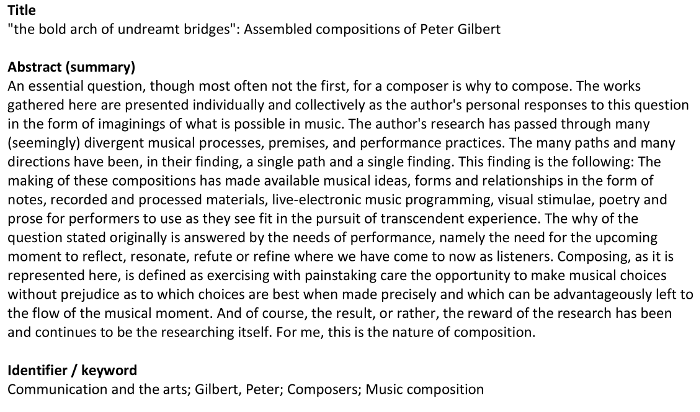
Figure 5. Abstract without titles or description of the content (PQDT record).
Note: Commas separating PQDT keywords have been replaced with semicolons for clarity.
Dissertation consists of a portfolio of scores, for seven musical works: Revealing Distant Cities;
Hear as the Night Hollows; Be Your Tears Wet; Allen den stillen Geschwistern in Winde der Wiesen;
NachtErwachen; Burn; Bold arch of Undreamt Bridges.
Source: Gilbert, “The Bold Arch of Undreamt Bridges” (ProQuest record)
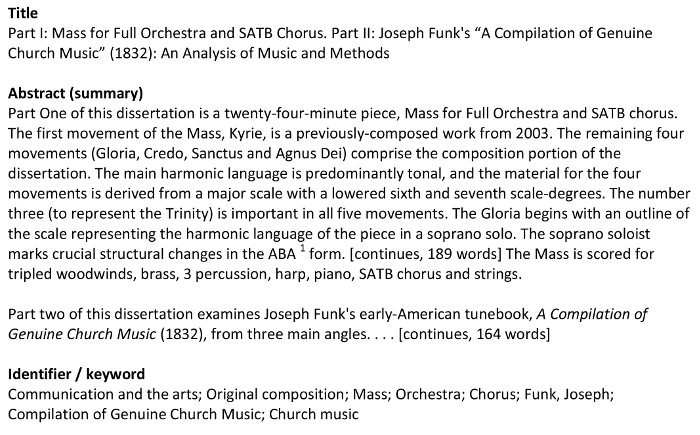
Figure 6. Abstract for multi-part document (PQDT record).
Note: Commas separating PQDT keywords have been replaced with semicolons for clarity.
Dissertation consists of the score for the work, Mass for Full Orchestra and SATB Chorus,
and the written text “Joseph Funk’s ‘A Compilation of Genuine Church Music’ (1832): An Analysis of Music and Methods.”
Source: Doerfler, “Mass for Full Orchestra and SATB Chorus (ProQuest record)
Study challenges and limitations
The option to contact individual institutions for a list of doctoral degree recipients instead of using PQDT searches was considered at the outset. It is possible that records for dissertations with severely deficient metadata, particularly in citation-only records, were not identified using the method here; however, that means the present results represent a best-case metadata scenario. The use of PQDT itself omits institutions that do not require PQDT submission. These include schools in the OhioLINK consortium, which provides a free, online database of theses and dissertations, with full text unless students request and receive a publication embargo.28
Future study
Looking outside of PQDT, the data can support future comparison of PQDT dissertation records to corresponding records in library catalogs or IRs. Similar to previous studies, keywords could be compared to a controlled vocabulary such as LCSH for content and format or the Thesaurus of Graphic Materials for format, and keywords, abstracts, and titles could be analyzed for overlap. The PQDT keywords as a set may be used as a source for further analysis of possible clustering of terms. Individual institutions or consortia can use evaluation methods described here to analyze or improve local practices for the dissertation submission process.
Recommendations
Identifying areas where incomplete or inconsistent PQDT metadata places the ability to retrieve dissertation records below the desired threshold presents an opportunity for improved description and discovery. Authors and departmental or institutional faculty and staff can make improvements during several stages of the dissertation process. At the writing stage, students and advisors can ensure that abstracts serve as stand-alone descriptions in the absence of full-text documents and that work titles and other important information are included. Later, during the submission process, students have another chance to include the titles of their musical compositions even if the titles are not identifiable in the dissertation title or abstract. The academic department, library, or graduate school could issue discipline-specific guidelines or a checklist that address the PQDT fields students must complete using ProQuest’s ETD Administrator. An internally created form that utilizes dropdown menus for department and committee member names (a suggestion from Lubas’s study)29 may be an option; a simpler option may be to require pre-approval of an electronic version of information to be copied into ProQuest. Findings reported in the literature suggest that additional value is provided when librarians or IR curators add description to author-supplied information. For those institutions that utilize author-assigned dissertation metadata, cooperation between the library or IR administrator and the graduate school or department could increase efficiency in local metadata workflow.
Conclusion
In this study, records in PQDT for 910 doctoral dissertations in music composition were analyzed to answer five questions: to what extent works are identified as compositions or scores, how many keywords are assigned and how they are distributed, what subject categories are assigned, and to what degree titles of musical works are represented in the PQDT metadata fields of title, abstract, and keyword. Results indicate some areas where students are providing thorough metadata in PQDT records, such as universal inclusion of appropriate subject categories. Although it was possible to analyze quantitatively the extent to which music composition dissertations are identified as original compositions or scores in PQDT records (roughly 77% and 3%, respectively), the extent of the impact on access is unclear. Keyword distribution across the set of all 910 records indicates multiple terms representing identical concepts. While this study analyzed clusters only of the most frequently occurring terms, it demonstrates complications arising from the use of freely assigned terms. It is in the area of representing titles of musical works—fully lacking from one tenth of the PQDT records analyzed—that students and institutions have the ability to immediately implement a positive change. Improvements would enhance discoverability in ProQuest as well as in freely accessible resources that depend at least in part on PQDT metadata. Awareness of the importance of representing their academic or creative documents will serve students well throughout their careers. Doctoral dissertations reflect a significant commitment of time and intellectual output. It is imperative that access is not obscured by something as seemingly simple as the omission of the musical work’s title from an abstract or keyword during the submission process.
Notes
1Portions of preliminary results of this study were presented as a poster at the 2014 annual conference of the Music Library Association.
2The College Music Society, Directory of Music Faculties. The total number of U.S. programs that include “composition” in the 2013-2014 CMS Directory’s Index of Graduate Degrees is 31; that figure does not include additional degree programs such as electronic arts or church music that include significant composition components including dissertation documents.
3OCLC, “OCLC WorldCat.” WorldCat is a collective catalog of libraries worldwide provided by OCLC. Participating libraries create or share records in or with the WorldCat database, which may be searched through both free and subscription interfaces.
4In a telephone conversation with the author on August 1, 2014, a representative from ProQuest's Author-School Relations Department indicated that PQDT editors may supply additional keywords to PQDT records after reviewing dissertation abstracts and titles.
5Lippincott and Lynch, “ETDs and Graduate Education,” 9. Their 2008 Coalition for Networked Information survey indicated that 47% of responding institutions relied on ProQuest to preserve a digital copy of ETDs.
6ProQuest, “ProQuest Dissertations and Theses Database;” Library of Congress, “Landmark Agreement with UMI.” UMI became known as ProQuest in 2001.
7ProQuest, “Search Engines and Your Dissertation.” Authors have the option to opt out of web and Google indexing.
8Limbert, “Timepiece.”
9Slegowski, “Resonance.”
10Hurley, “Jeanne d’Arc on the 1870s Musical Stage.”
11McCutcheon, “Basic, Fuller, Fullest,” 64-68.
12Ibid., 65.
13Lubas, “Best Practices,” 260.
14Strader, “Author-Assigned Keywords,” 243-50.
15Schwing, McCutcheon, and Maurer, “Uniqueness Matters,” 903-28.
16Ibid., 921.
17Maurer, McCutcheon, and Schwing, “Author-Supplied ETD Metadata,” 299.
18Keller, “Subject Content through Title,” 69-80.
19Sapon-White and Hansbrough, “Impact of Subject Heading Assignment,” 282-91.
20Ibid., 290.
21Keller, “Subject Content through Title,” 72.
22Fineman, “Electronic Theses and Dissertations in Music,” 893-907.
23Dougan, “Emerging Musicology Research,” 109-30.
24Wolverton, Hoover, and Fowler, “Subject Analysis of Theses and Dissertations,” 206.
25Ibid., 210.
26ProQuest, “2011–2012 Subject Category Guide.”
27The conversation with the Author Relations Department indicates this is possible; subsequent requests for clarification from ProQuest regarding the particular term “communication and the arts” were not returned.
28“OhioLINK ETD Center.”
29Lubas, “Best Practices,” 260.
Bibliography
College Music Society. Directory of Music Faculties in Colleges and Universities, U.S. and Canada 2013-2014. Missoula, MT: College Music Society, 2013.
Doerfler, Amy M. “Part I: Mass for Full Orchestra and SATB Chorus. Part II: Joseph Funk's ‘A Compilation of Genuine Church Music’ (1832): An analysis of music and methods.” PhD diss., Kent State University, 2011. ProQuest record. ProQuest (AAT 3476653). http://search.proquest.com/pqdtft/docview/898610947/abstract/.
Dougan, Kirstin. “Dissertations in the Electronic Age: Tapping into Emerging Musicology Research.” Music Reference Services Quarterly 14, no. 3 (2011): 109-30. doi: 10.1080/10588167.2011.596094.
Escalante-Chernova, Irina. “Cuban Scenery and Figurations for Chamber Orchestra and Tape.” DMus diss., Florida State University, 2009. ProQuest record. ProQuest (AAT 3373989). http://search.proquest.com/pqdtft/docview/304877619/abstract/.
Fineman, Yale. “Electronic Theses and Dissertations in Music.” Notes 60, no. 4 (Jun. 2004): 893-907. doi: 10.1353/not.2004.0053.
Gilbert, Peter Andrew. “‘The Bold Arch of Undreamt Bridges’: Assembled Compositions of Peter Gilbert.” PhD diss., Harvard University, 2008. ProQuest record. ProQuest (AAT 3334735). http://search.proquest.com/pqdtft/docview/304601639/abstract/.
Hurley, Therese. “Jeanne d’Arc on the 1870s Musical Stage: Jules Barbier and Charles Gounod’s Melodrama and Auguste Mermet’s Opera.” PhD diss., University of Oregon, 2013. ProQuest (AAT 3563584).
Keller, Barbara. “Subject Content through Title: A Masters Theses Matching Study at Indiana State University.” Cataloging & Classification Quarterly 15, no. 3 (1992): 69-80. doi: 10.1300/J104v15n03_05.
Library of Congress. “Library of Congress and Copyright Office Sign Landmark Agreement with UMI,” PR 99-006, January 22, 1999, http://www.loc.gov/today/pr/1999/99-007.html.
Limbert, Thomas. “Timepiece.” PhD diss., Duke University, 2010. ProQuest (AAT 3398439).
Lippincott, Jean K., and Clifford A. Lynch. “ETDs and Graduate Education: Programs and Prospects.” Research Library Issues: A Bimonthly Report from ARL, CNI, and SPARC 270 (June 2010): 6-15.
Lubas, Rebecca L. “Defining Best Practices in Electronic Thesis and Dissertation Metadata.” Journal of Library Metadata 9, no. 3-4 (2009): 252-63. doi: 10.1080/19386380903405165.
Maurer, Margaret Beecher, Sevim McCutcheon, and Theda Schwing. “Who’s Doing What? Findability and Author-Supplied ETD Metadata in the Library Catalog.” Cataloging & Classification Quarterly 49, no. 4 (2011): 277-310. doi: 10.1080/01639374.2011.573440.
McCutcheon, Sevim. “Basic, Fuller, Fullest: Treatment Options for Electronic Theses and Dissertations.” Library Collections, Acquisitions, and Technical Services 35, no. 2-3 (2011): 64-68. doi: 10.1080/14649055.2011.10766300.
OCLC, “OCLC WorldCat,” accessed November 16, 2014, http://www.oclc.org/worldcat.en.html.
Ohio Library and Information Network, “OhioLINK ETD Center,” accessed November 22, 2014, http://etd.ohiolink.edu.
ProQuest. “ProQuest Dissertations and Theses Database,” accessed November 22, 2014, http://www.proquest.com/products-services/pqdt.html.
ProQuest. “Search Engines and Your Dissertation,” accessed November 22, 2014, http://www.proquest.com/products-services/dissertations/Search-Engines-and-Your-Dissertation.html.
ProQuest, “2011–2012 Subject Category Guide,” accessed November 22, 2014, http://www.etdadmin.com/UMI_SubjectCategoriesGuide.pdf.
Sapon-White, Richard E., and Mary Hansbrough. “The Impact of Subject Heading Assignment on Circulation of Dissertations at Virginia Tech.” Library Resources & Technical Services 42, no. 4 (1998): 282-91.
Schwing, Theda, Sevim McCutcheon, and Margaret Beecher Maurer. “Uniqueness Matters: Author-Supplied Keywords and LCSH in the Library Catalog.” Cataloging & Classification Quarterly 50, no. 8 (2012): 903-28.
Slegowski, Eric. “Resonance.” DMA diss., University of Maryland, 2010. ProQuest (AAT 3409849).
Strader, C. Rockelle. “Author-Assigned Keywords versus Library of Congress Subject Headings: Implications for the Cataloging of Electronic Theses and Dissertations.” Library Resources & Technical Services 43, no. 4 (2009): 243-50.
Thomas, Robert E. “Composition with Layered Structures, and, Trio for Violin, Clarinet in A and Marimba.” ProQuest record. PhD diss., Rutgers, 2004. ProQuest (AAT 3134899). http://search.proquest.com/pqdtft/docview/305154730/abstract/.
Wolverton, Robert E., Lona Hoover, and Robert Fowler. “Subject Analysis of Theses and Dissertations: A Survey.” Technical Services Quarterly 28, no. 2 (2011): 201-22. doi: 10.1080/07317131.2011.546276.


